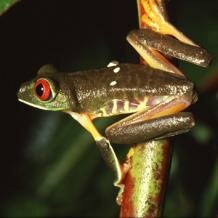Topic: Tongues of chameleons and amphibians
[p]Convergence in tongue function represents repeated morphological exploration within different lineages made possible by loss of an ancestral functional constraint[/p]
 In humans tongues are essential for feeding, speaking, and well, one or two other functions. One thing we cannot do, however, is flick a fly off a wall in the manner of the chameleon and many amphibians. The latter are celebrated for their rapidly protrusible tongues and ability to take an insect on its voyage to eternity in a split-second. The biomechanics of such protrusion are very interesting, and it turns out that there are three basic varieties. Are you surprised to learn they are also convergent?
In humans tongues are essential for feeding, speaking, and well, one or two other functions. One thing we cannot do, however, is flick a fly off a wall in the manner of the chameleon and many amphibians. The latter are celebrated for their rapidly protrusible tongues and ability to take an insect on its voyage to eternity in a split-second. The biomechanics of such protrusion are very interesting, and it turns out that there are three basic varieties. Are you surprised to learn they are also convergent?
 The case of the plethodontid salamanders is particularly interesting because being without lungs this has allowed them to redeploy the associated musculo-skeletal elements for tongue functions, with the added bonus that those that have evolved direct-development have, of course, lost the larvae and so no longer require musculature normally employed for larval suction feeding.
The case of the plethodontid salamanders is particularly interesting because being without lungs this has allowed them to redeploy the associated musculo-skeletal elements for tongue functions, with the added bonus that those that have evolved direct-development have, of course, lost the larvae and so no longer require musculature normally employed for larval suction feeding.
As Mueller and her colleagues write the “Convergence in tongue function represents repeated morphological exploration within different lineages made possible by loss of an ancestral functional constraint”. Of the three categories of tongue protrusion the ballistic is arguably the most spectacular, and a similar arrangement has also evolved in frogs (but the tongue has no skeletal components) and chameleon (but here the mechanism is reversed).
Cite this web page
Map of Life - "Tongues of chameleons and amphibians"
https://mapoflife.org/topics/topic_51_tongues-of-chameleons-and-amphibians/
November 29, 2020

